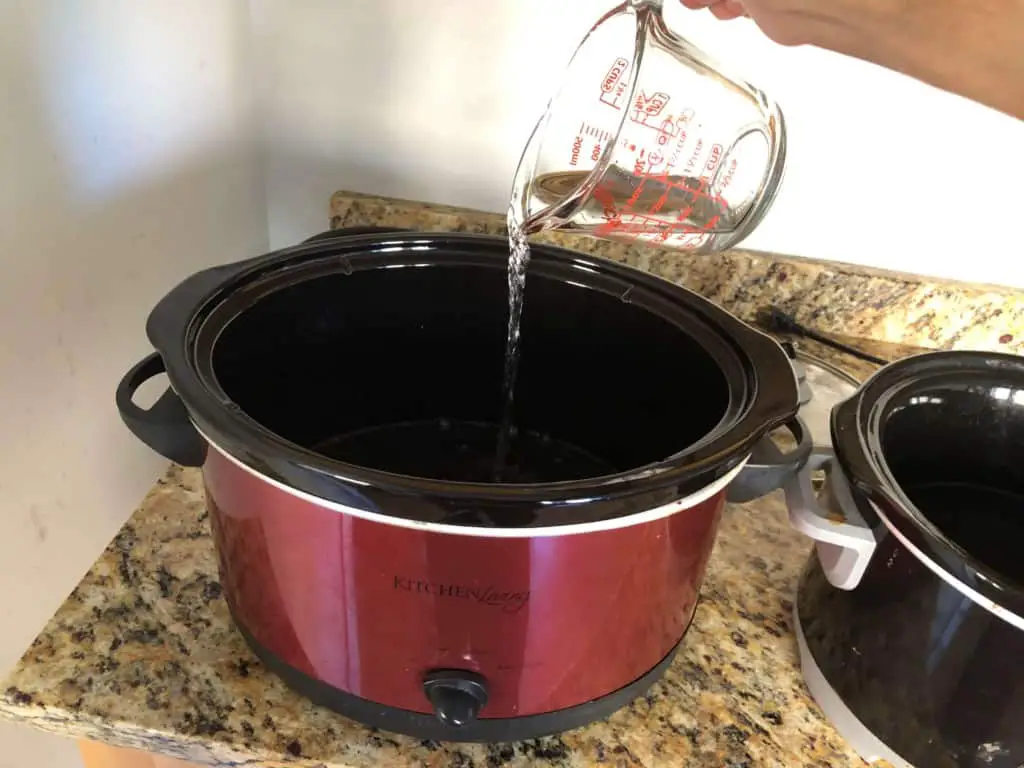
Today we’re going to cover one of the most common questions about cooking with a crock pot. Specifically: “Do crock pots need water to cook?”
You only need to add water to a crock pot if the meal or recipe you’re using requires it. Some foods will produce their own liquid as they cook, like fatty meats and vegetables. Some leaner meats will need to have liquid added so the slow cooker dish does not get scorched.
I have some specific recipes that I’d like to share with you as examples. Some of them do require water, and some of them don’t. But first, let’s take a quick look at what the Crock Pot instruction manual says about adding liquid.
Table of Contents
Do Crock Pots Need Water?

Adding liquid to a crock pot is only required if it’s necessary for the recipe you are cooking. And I’ll also note, that you only ever add water to the pot (as shown above) and NEVER to the slow cooker base where the heating element is.
If you read the instruction manual that comes with Crock Pot brand slow cookers, it makes two points about liquid. Here’s the first one:
“For best results and to prevent food from drying or burning, always ensure an adequate amount of liquid is used in the recipe.”
Notice that they say “adequate” here. In other words, they’re saying to use “enough” liquid which, of course, means it will vary from recipe to recipe.
So, in my opinion, the Crock Pot instruction manual agrees that liquid is dependent on the specific recipe that you plan to cook.
The second point about liquid that is made in the Crock Pot instruction manual, is as follows:
“Ensure the stoneware is always filled a minimum of ½ full and a maximum of ¾ full, and conform to recommended cook times.”
I think this point is worth noting, and you may get different answers depending on who you ask. Given the context, it may appear that the Crock Pot should be filled 1/2 to 3/4 full with liquid.
And sure, that may be the case with some recipes. Like soups, for example.
However, I interpret this differently. I think it means that all ingredients should fill the Crock Pot 1/2 to 3/4 full. And I don’t think that liquid necessarily has to be a part of that volume.
One of the things to remember is that if you’re cooking raw meats and vegetables, those ingredients contain moisture. So, as you cook them down, their moisture will be released which essentially creates its own liquid.
I’ve personally cooked a really delicious pot roast in a slow cooker filled about 3/4 full, without adding any extra liquid. It turned out great! Just make sure all the ingredients (especially meats) are fully cooked, of course.
If you want to double-check the specific instruction manual for your crock pot, you can do a Google search and find your specific brand and model. But, here’s a link to crock pots manual section in case you have that brand.
How Much Water to Add to Your Slow Cooker
Saying you don’t always need to add water to your slow cooker doesn’t exactly tell you how much liquid actually needs to be in your crock pot.
So here’s a general rule of thumb:
If you are cooking a non-liquid-based dish (not soup) then you should add 1/2 to one cup of water or liquid, just enough to cover the bottom of the dish so that your ingredients don’t get scorched.
If you are cooking a soup or liquid-based meal (soup), then you should add as much liquid as you need to get your desired consistency.
Lastly, if you don’t add enough water at the beginning, you can always add more water, but, you want to add how water or hot liquid to the pot because it will keep the temperature high. If you add cold water, it will bring down the temperature of the ingredients and increase the cooking time.
When it comes to slow-cooked meals, when in doubt; follow a recipe. When they come from good sources, slow cooking recipes are created and tested to make sure that everything is cooked safely.
So, if you’re not sure how long you should cook your pork shoulder or your root vegetables, just look for a recipe for your ingredients to make sure they’re being cooked long enough.
Now, let’s walk through several example recipes that are designed for slow cookers. Some of them require water, some of them do not, and others require liquid (but not water).
Let’s get to it!
7 Recipe Examples
No Added Water – Recipe Examples
To start with, here are a few slow cooker recipes that do not require any added water.
1. Whole chicken crock pot recipe – by dinneratthezoo.com
2. Ham crock pot recipe – by allrecipes.com
As you can see, these are both large meat dishes. That’s the first type of meal that came to mind for me in this category, but you might have some other ideas that came to mind for you.
Add Liquid, Not Water – Recipe Examples
Next up, I wanted to give some slow-cooker recipes where you do have to add liquid, but not water specifically.
3. Chili crock pot recipe – by cookingclassy.com
4. Slow cooker queso recipe – by rachelcooks.com
Looking at all this delicious food is making me hungry, maybe I’ll break out my crock pot and cook some of these recipes myself.
Need to Add Water – Recipe Examples
Finally, here are a couple of examples where you DO need to add water to the recipe.
5. Chicken noodle soup crock pot recipe – by food.com
6. Slow cooker bread recipe – bakedbyanintrovert.com
7. Pot roast crock pot recipe – dinnerthendessert.com
Interestingly, recipe #7 (pot roast) only uses water towards the end of cooking, in order to create a thickening agent by mixing in water/corn starch.
Alright, now let’s talk more about cooking meat in a slow cooker.
Should Meat be Covered with Liquid in a Slow Cooker?

Meat only needs to be covered with liquid in a slow cooker if the recipe calls for it. In addition, to covering meat in liquid, you don’t necessarily have to add that liquid. For instance, if you are cooking a pot roast in a crock pot, the vegetables and meat will release liquid as they cook.
These juices from the ingredients alone can be enough to cover the meat.
With that said, it’s also important to note that liquid does transfer heat more effectively than air does. So, a piece of meat that is submerged will cook differently than a piece of meat that is not submerged.
In addition, if you are cooking a dish, and only part of the meat is submerged, then the submerged food cooks differently than the exposed portion.
As a result, whichever approach you use, you might need to add or remove water so that the meat will be either fully submerged or fully exposed. That way the meat cooks evenly.
Can You Put Raw Meat in a Slow Cooker?
You can put raw meat in a crock pot for dishes like chicken breast or chicken thighs, but if you are cooking a soup or chili, then you may need to cook the meat separately to avoid the risk of undercooking the meat. Check your recipe for guidance.
To further illustrate this point, I love to make chili in my crock pot, and I ALWAYS brown the meat in a frying pan on the stove before adding it to the crock pot.
This ensures that the meat is fully cooked, and I’ve also read that it can improve the flavor of the meat (and thus the flavor of the chili) by cooking it in spices before you add it to the slow cooker. So, in some cases, you’ll need to sear or brown your meat before adding it to the slow cooker.
On the other hand, if you’re cooking something that is more “meat-centric”, then you might not need to cook the meat at all before putting it in the crock pot.
The perfect example of this is a pot roast, which I cook ALL the time (okay, probably more like once a month). When I make pot roast, I add the raw meat directly to the slow cooker without any prior cooking. Just make sure the meat is fully cooked before consuming it.
You can check how done your meat is using a food thermometer like this one on Amazon. Here’s a table from the U.S. Department of Agriculture of the internal temperatures that food should reach to be safe to eat.
| Product | Minimum Internal Temperature & Rest Time |
| Beef, Pork, Veal & Lamb Steaks, chops, roasts | 145 °F (62.8 °C) and allow to rest for at least 3 minutes |
| Ground Meats | 160 °F (71.1 °C) |
| Ground Poultry | 165 °F |
| Ham, fresh or smoked (uncooked) | 145 °F (62.8 °C) and allow to rest for at least 3 minutes |
| Fully Cooked Ham (to reheat) | Reheat cooked hams packaged in USDA-inspected plants to 140 °F (60 °C) and all others to 165 °F (73.9 °C). |
| All Poultry (chicken breasts, whole bird, legs, thighs, wings, ground poultry, giblets, and stuffings | 165 °F (73.9 °C) |
| Eggs | 160 °F (71.1 °C) |
| Fish & Shellfish | 145 °F (62.8 °C) |
| Leftovers and Casseroles | 165 °F (73.9 °C) |
Following this table will make sure you don’t inadvertently give anyone food poisoning. You should also ensure that meat is fully thawed before adding it to a crock pot.
Related Questions
Crock Pot Temperature on Low Temperature and High Temperature?
Slow cookers will generally heat at about 190-210 degrees Fahrenheit (~87-99 degrees Celsius) on low heat and up to about 300 degrees Fahrenheit (~149 degrees Celsius) on high heat. However, slow cooker temperatures will vary based on cook time, brand, model, etc. For more info, check out this post.
Can You Boil Water in a Crock Pot?
You can boil water in a crock pot, but it will take about 2 hours or longer on the High setting. The exact time will vary depending on the amount of water and model of slow cooker. In addition, the water inside a crock pot will likely stabilize at a simmering boil and may never reach a full rolling boil.
Can You Put Aluminum Foil in a Crock Pot?
You can use aluminum foil in your crock pot. Cooking with aluminum foil has been shown to increase the aluminum contents of food by as much as 378%. However, medical researchers generally consider aluminum foil to be safe to cook with, and the increased aluminum exposure has not been shown to cause health problems.

